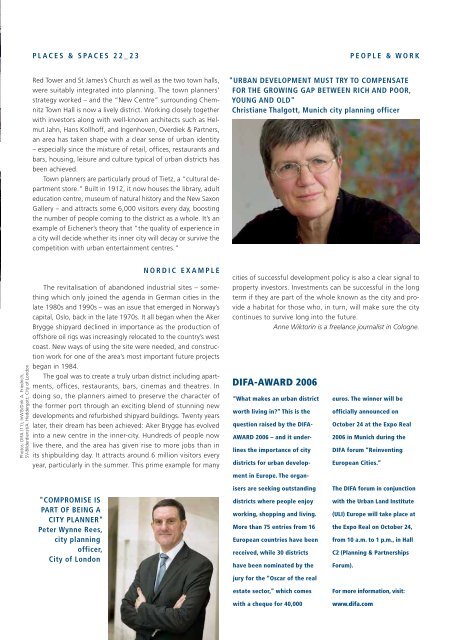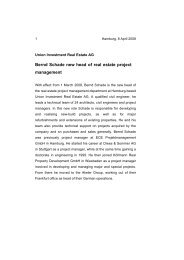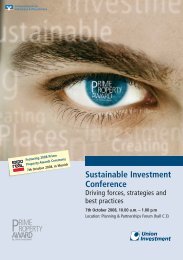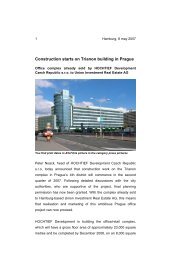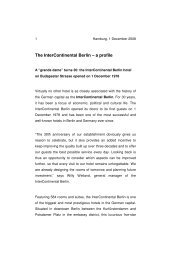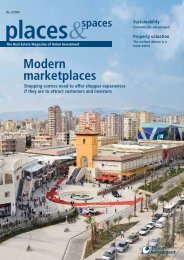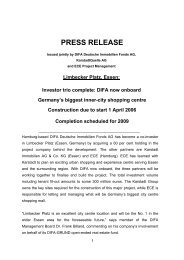BREAKTHROUGH IN THE CITY Why London's ... - Union Investment
BREAKTHROUGH IN THE CITY Why London's ... - Union Investment
BREAKTHROUGH IN THE CITY Why London's ... - Union Investment
Create successful ePaper yourself
Turn your PDF publications into a flip-book with our unique Google optimized e-Paper software.
Photos: DIFA (11); InWIS/Dirk A. Friedrich;<br />
SV-Bilderdienst/A. Heddergott; City of London<br />
PLACES & SPACES 22_23 PEOPLE & WORK<br />
Red Tower and St James’s Church as well as the two town halls,<br />
were suitably integrated into planning. The town planners’<br />
strategy worked – and the “New Centre” surrounding Chemnitz<br />
Town Hall is now a lively district. Working closely together<br />
with investors along with well-known architects such as Helmut<br />
Jahn, Hans Kollhoff, and Ingenhoven, Overdiek & Partners,<br />
an area has taken shape with a clear sense of urban identity<br />
– especially since the mixture of retail, offices, restaurants and<br />
bars, housing, leisure and culture typical of urban districts has<br />
been achieved.<br />
Town planners are particularly proud of Tietz, a “cultural department<br />
store.” Built in 1912, it now houses the library, adult<br />
education centre, museum of natural history and the New Saxon<br />
Gallery – and attracts some 6,000 visitors every day, boosting<br />
the number of people coming to the district as a whole. It’s an<br />
example of Eichener’s theory that “the quality of experience in<br />
a city will decide whether its inner city will decay or survive the<br />
competition with urban entertainment centres.”<br />
NORDIC EXAMPLE<br />
The revitalisation of abandoned industrial sites – something<br />
which only joined the agenda in German cities in the<br />
late 1980s and 1990s – was an issue that emerged in Norway’s<br />
capital, Oslo, back in the late 1970s. It all began when the Aker<br />
Brygge shipyard declined in importance as the production of<br />
offshore oil rigs was increasingly relocated to the country’s west<br />
coast. New ways of using the site were needed, and construction<br />
work for one of the area’s most important future projects<br />
began in 1984.<br />
The goal was to create a truly urban district including apartments,<br />
offices, restaurants, bars, cinemas and theatres. In<br />
doing so, the planners aimed to preserve the character of<br />
the former port through an exciting blend of stunning new<br />
developments and refurbished shipyard buildings. Twenty years<br />
later, their dream has been achieved: Aker Brygge has evolved<br />
into a new centre in the inner-city. Hundreds of people now<br />
live there, and the area has given rise to more jobs than in<br />
its shipbuilding day. It attracts around 6 million visitors every<br />
year, particularly in the summer. This prime example for many<br />
"COMPROMISE IS<br />
PART OF BE<strong>IN</strong>G A<br />
<strong>CITY</strong> PLANNER"<br />
Peter Wynne Rees,<br />
city planning<br />
officer,<br />
City of London<br />
"URBAN DEVELOPMENT MUST TRY TO COMPENSATE<br />
FOR <strong>THE</strong> GROW<strong>IN</strong>G GAP BETWEEN RICH AND POOR,<br />
YOUNG AND OLD"<br />
Christiane Thalgott, Munich city planning officer<br />
cities of successful development policy is also a clear signal to<br />
property investors. <strong>Investment</strong>s can be successful in the long<br />
term if they are part of the whole known as the city and provide<br />
a habitat for those who, in turn, will make sure the city<br />
continues to survive long into the future.<br />
Anne Wiktorin is a freelance journalist in Cologne.<br />
DIFA-AWARD 2006<br />
“What makes an urban district<br />
worth living in?” This is the<br />
question raised by the DIFA-<br />
AWARD 2006 – and it under-<br />
lines the importance of city<br />
districts for urban develop-<br />
ment in Europe. The organ-<br />
isers are seeking outstanding<br />
districts where people enjoy<br />
working, shopping and living.<br />
More than 75 entries from 16<br />
European countries have been<br />
received, while 30 districts<br />
have been nominated by the<br />
jury for the “Oscar of the real<br />
estate sector,” which comes<br />
with a cheque for 40,000<br />
euros. The winner will be<br />
officially announced on<br />
October 24 at the Expo Real<br />
2006 in Munich during the<br />
DIFA forum “Reinventing<br />
European Cities.”<br />
The DIFA forum in conjunction<br />
with the Urban Land Institute<br />
(ULI) Europe will take place at<br />
the Expo Real on October 24,<br />
from 10 a.m. to 1 p.m., in Hall<br />
C2 (Planning & Partnerships<br />
Forum).<br />
For more information, visit:<br />
www.difa.com


